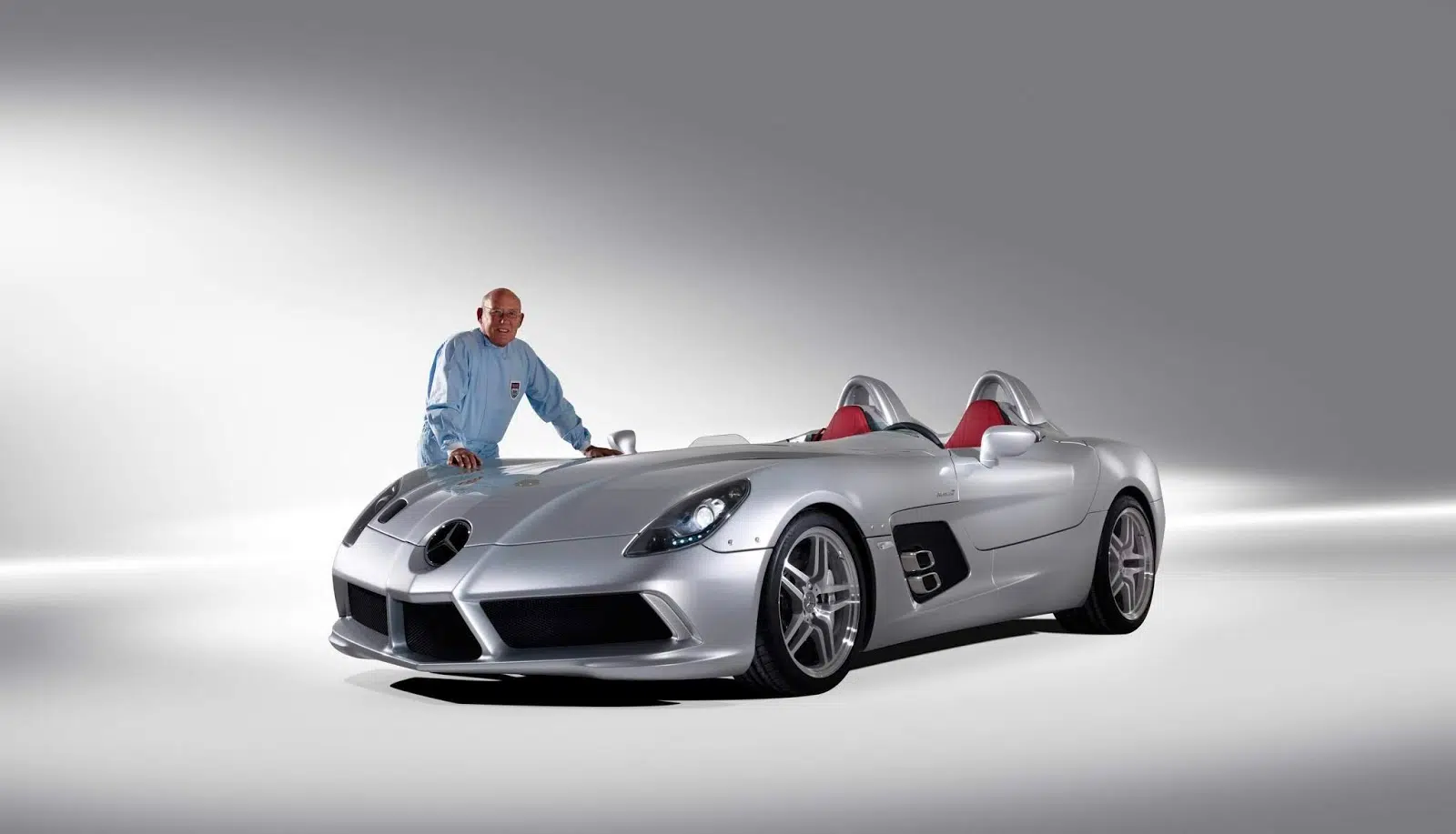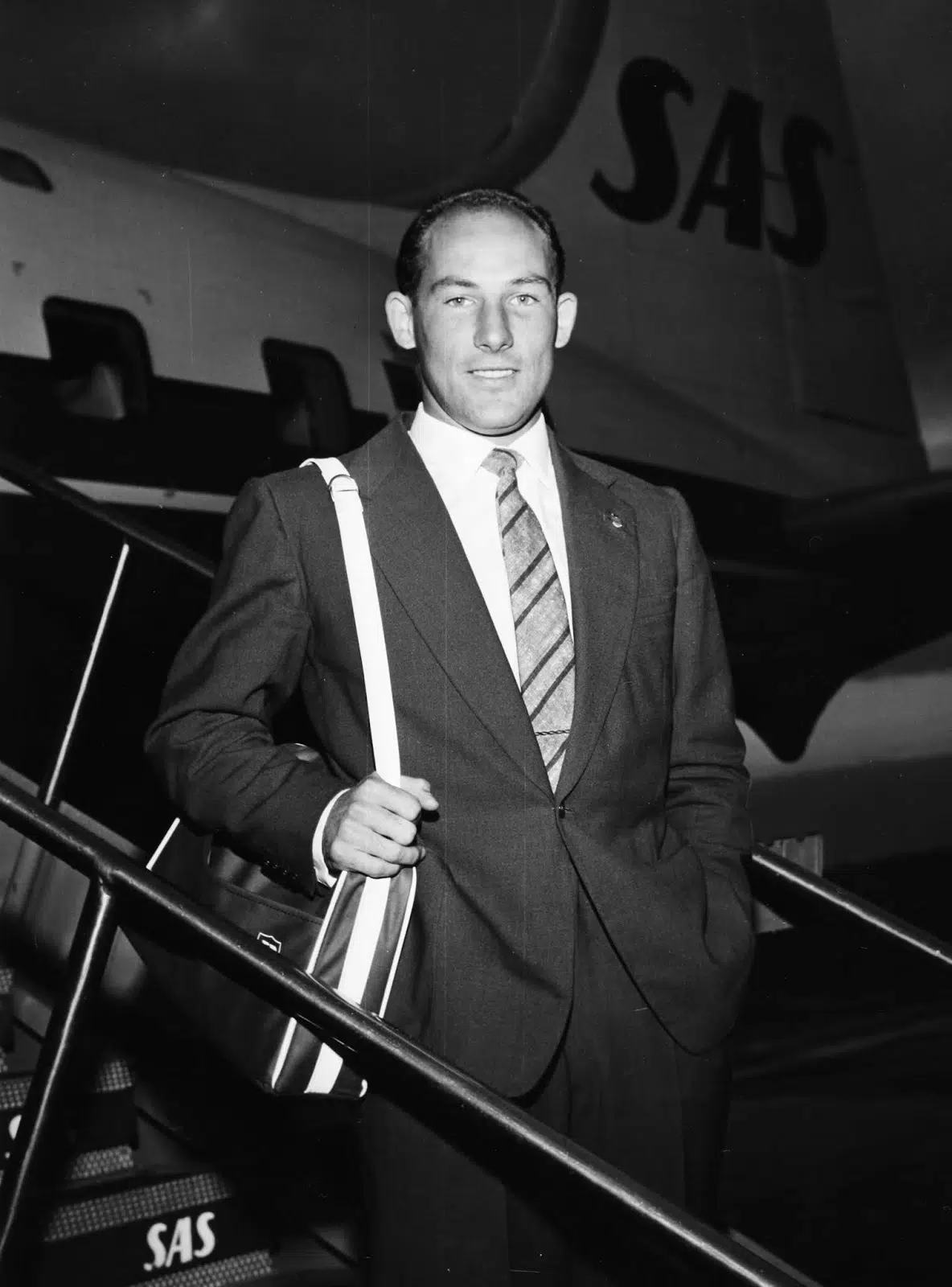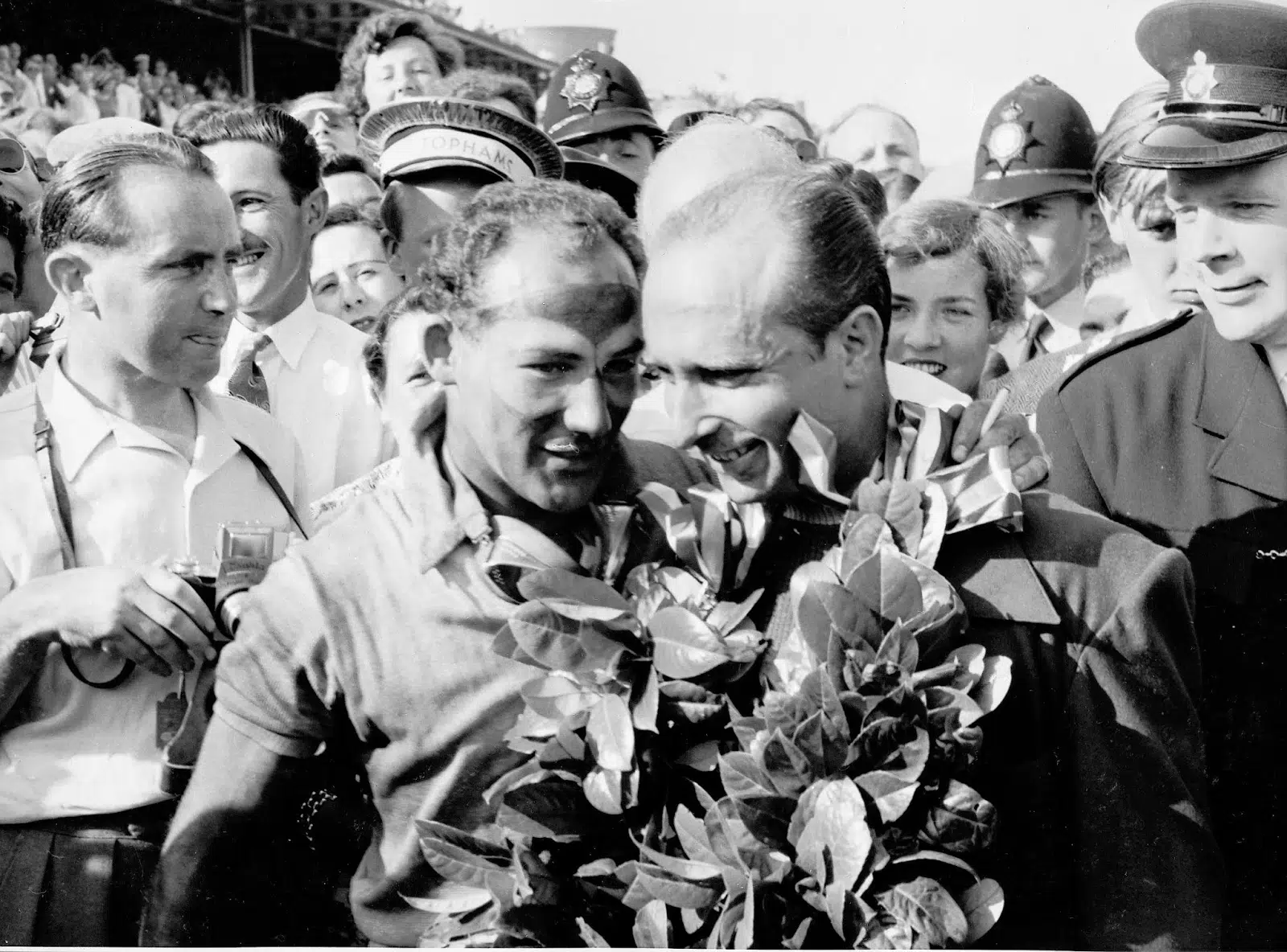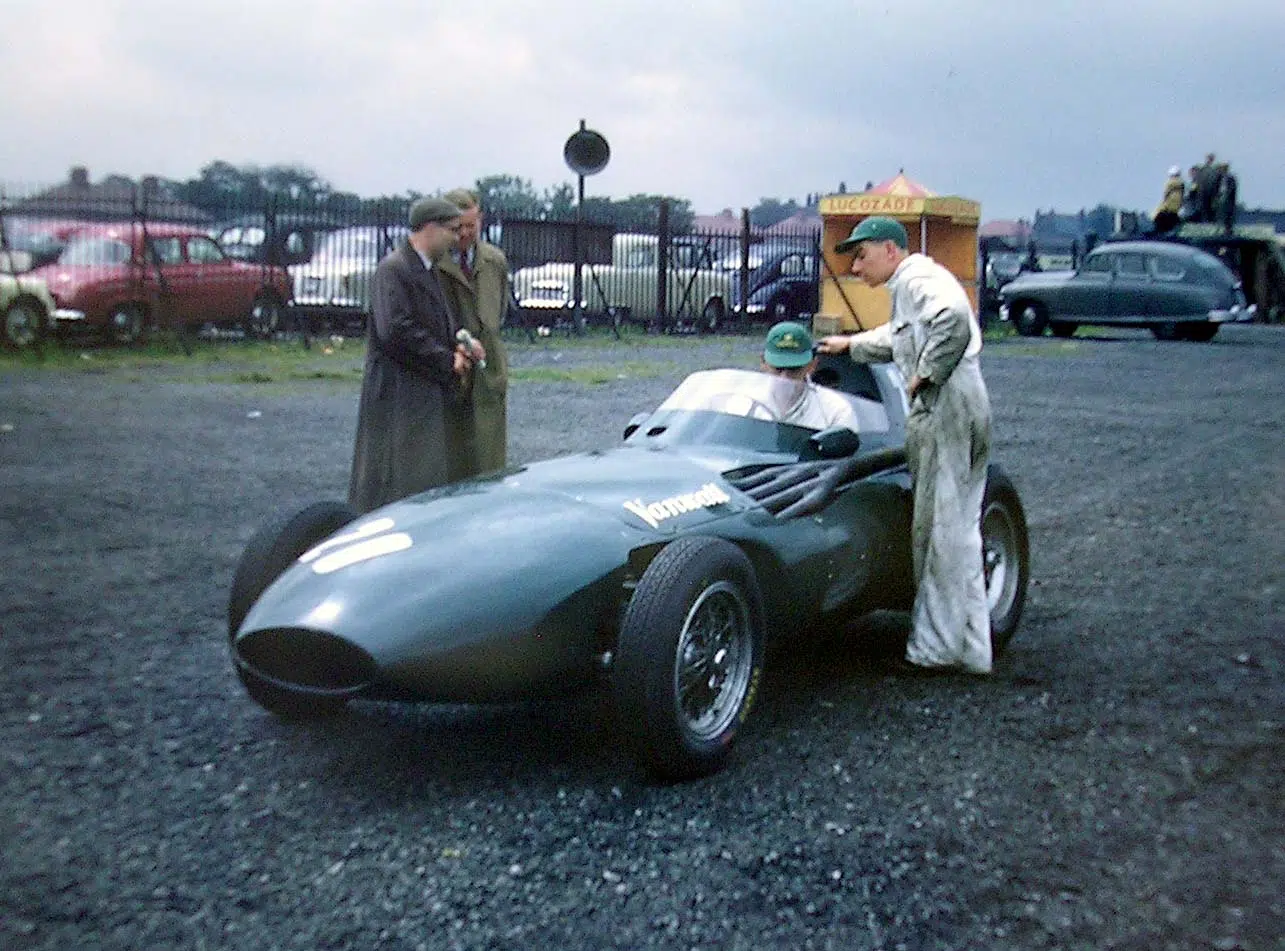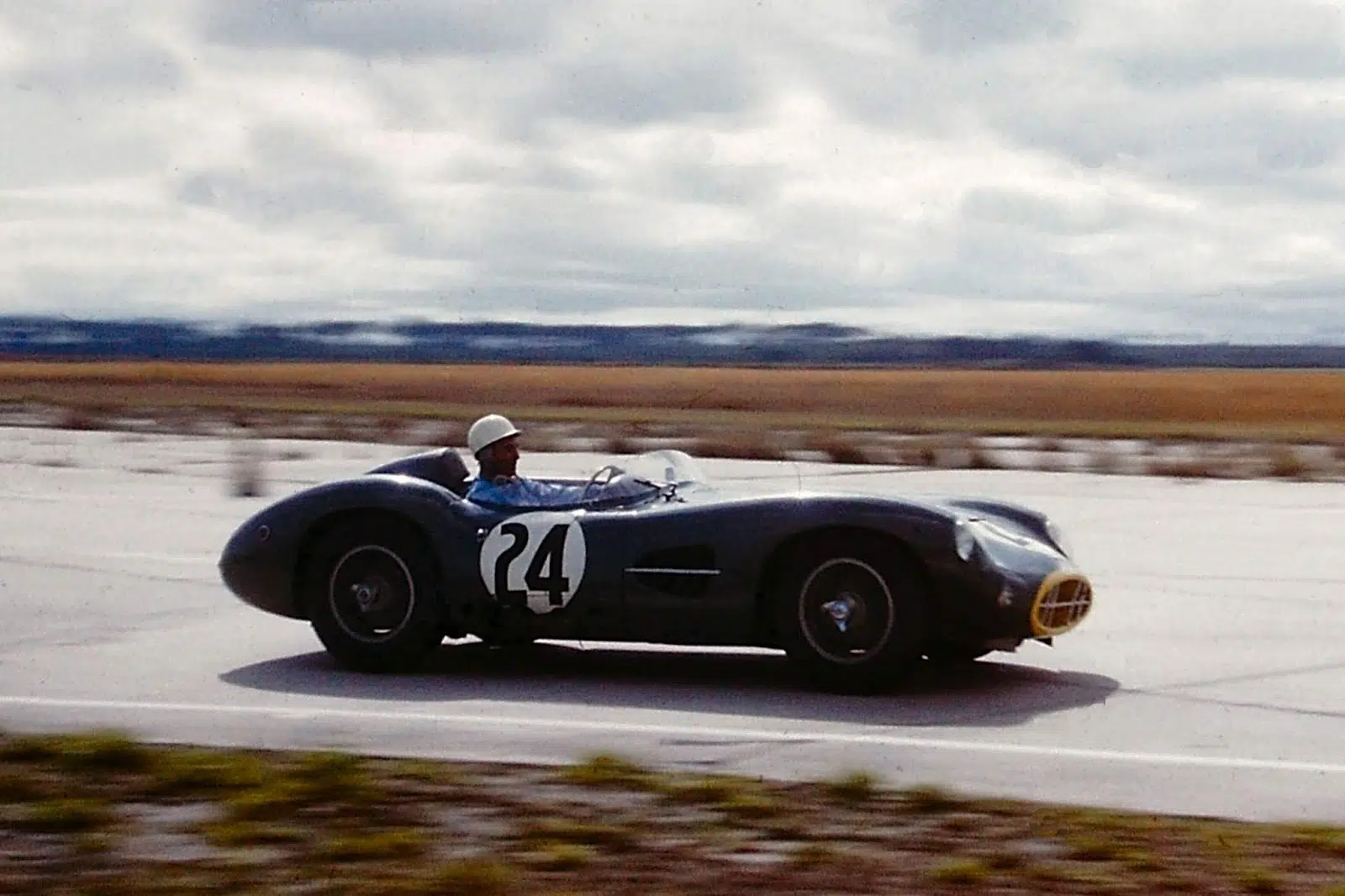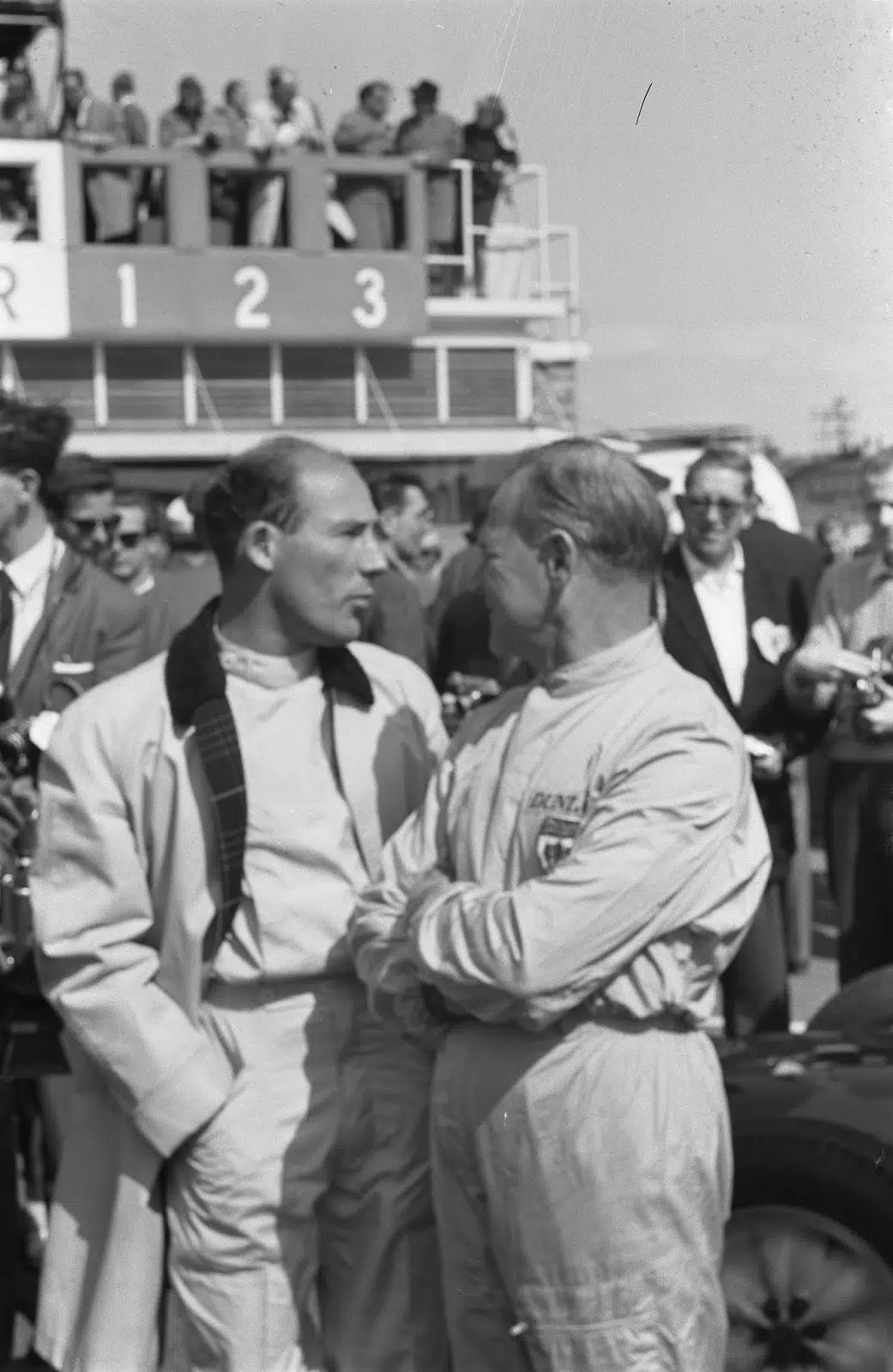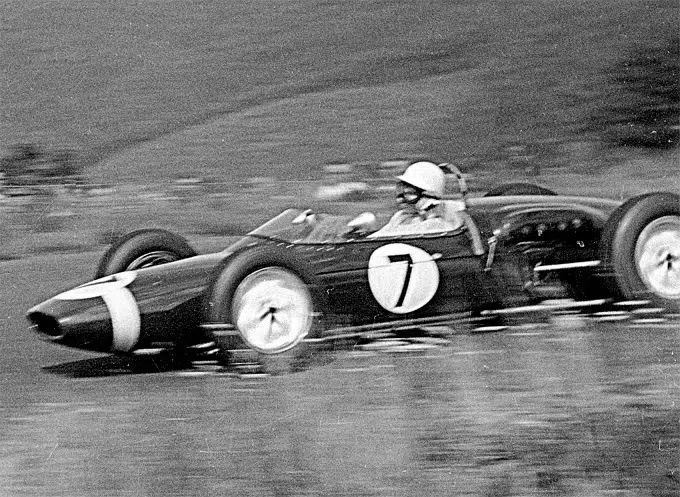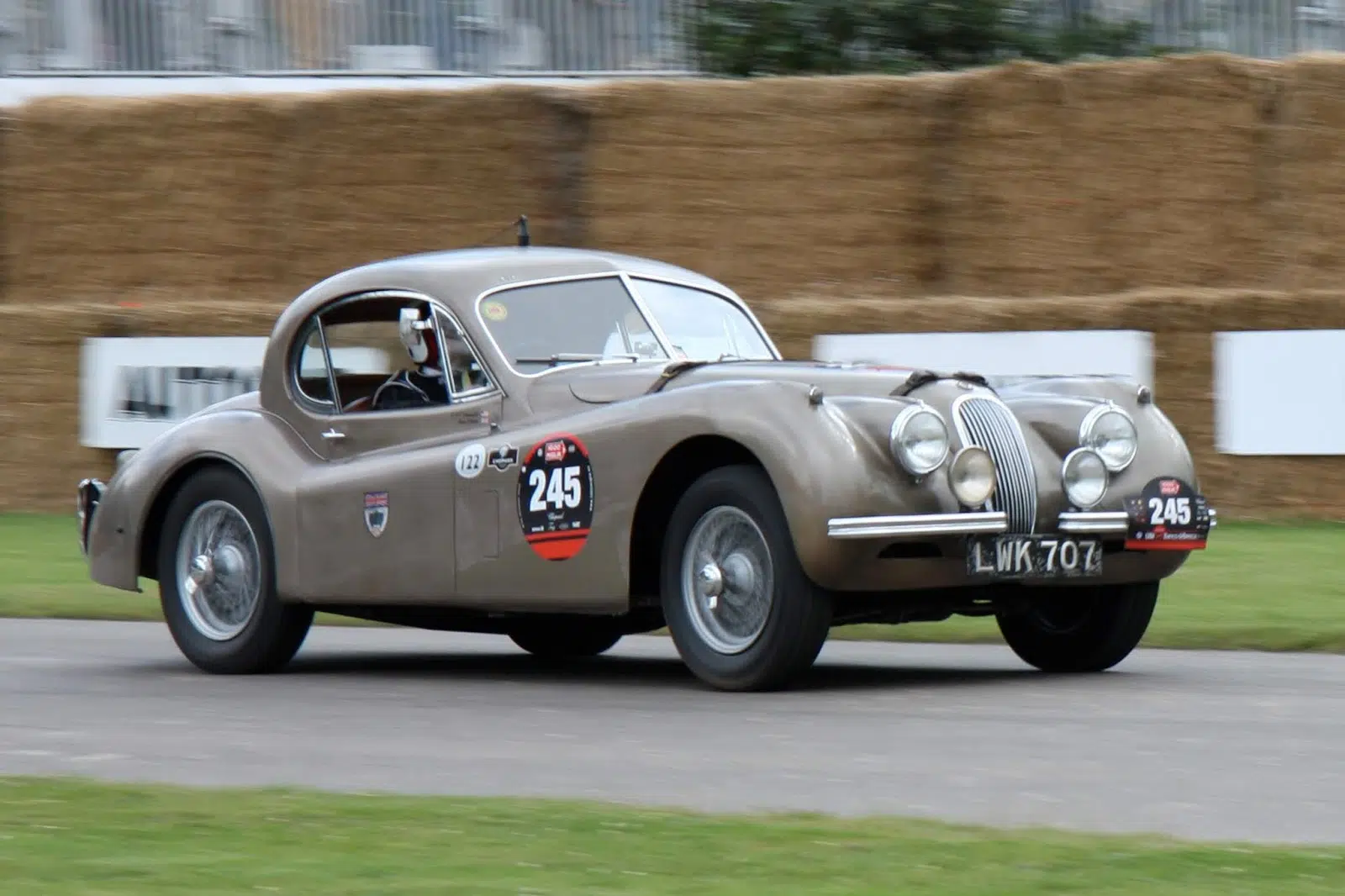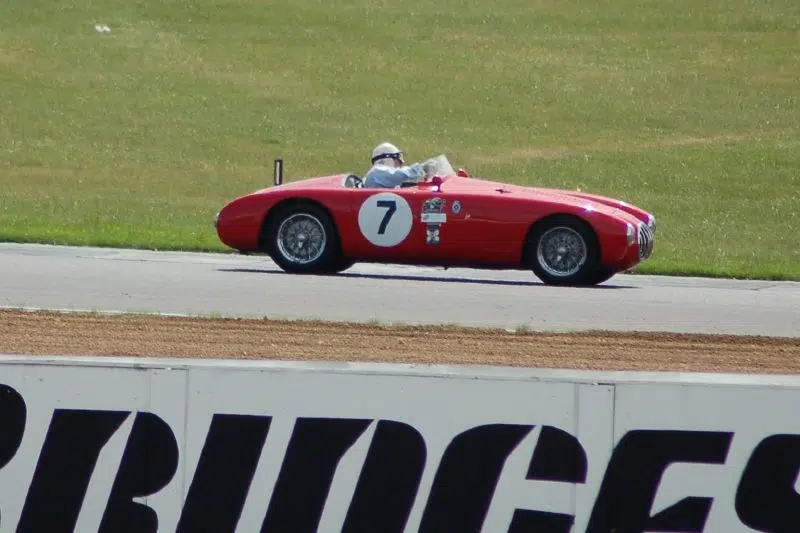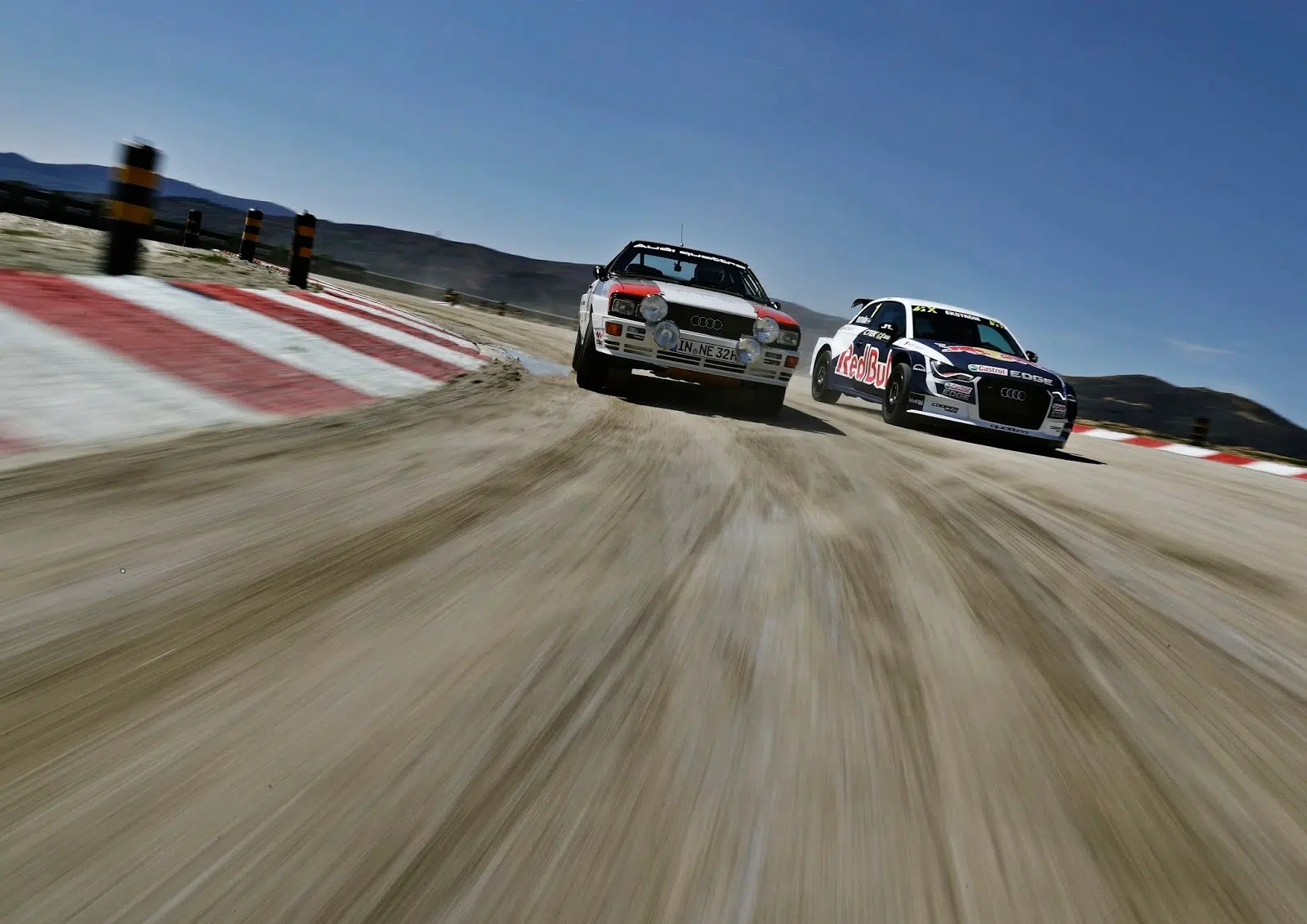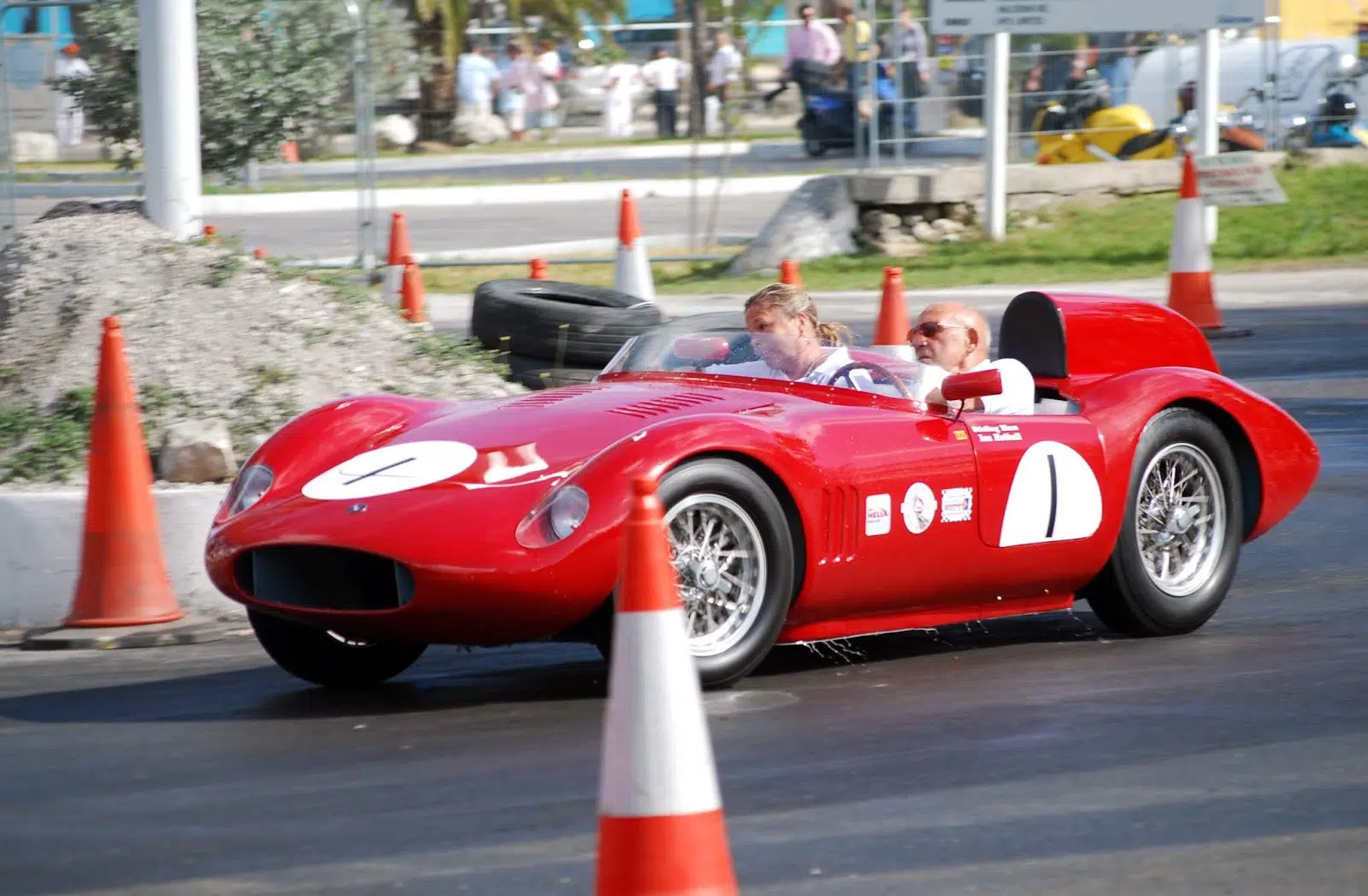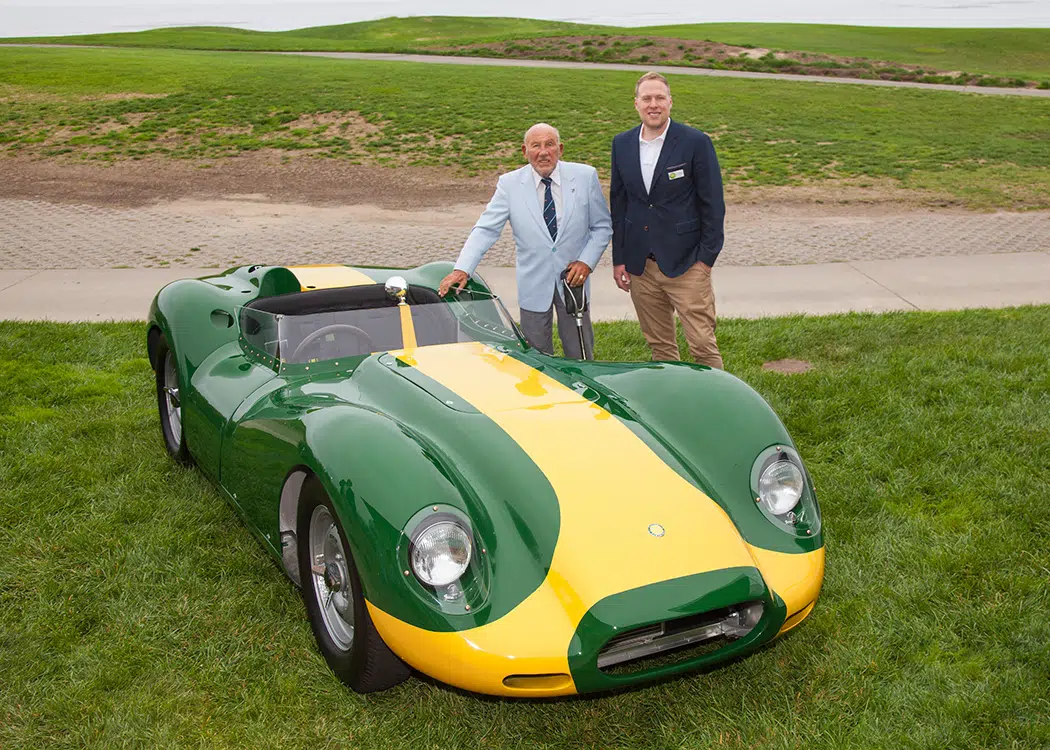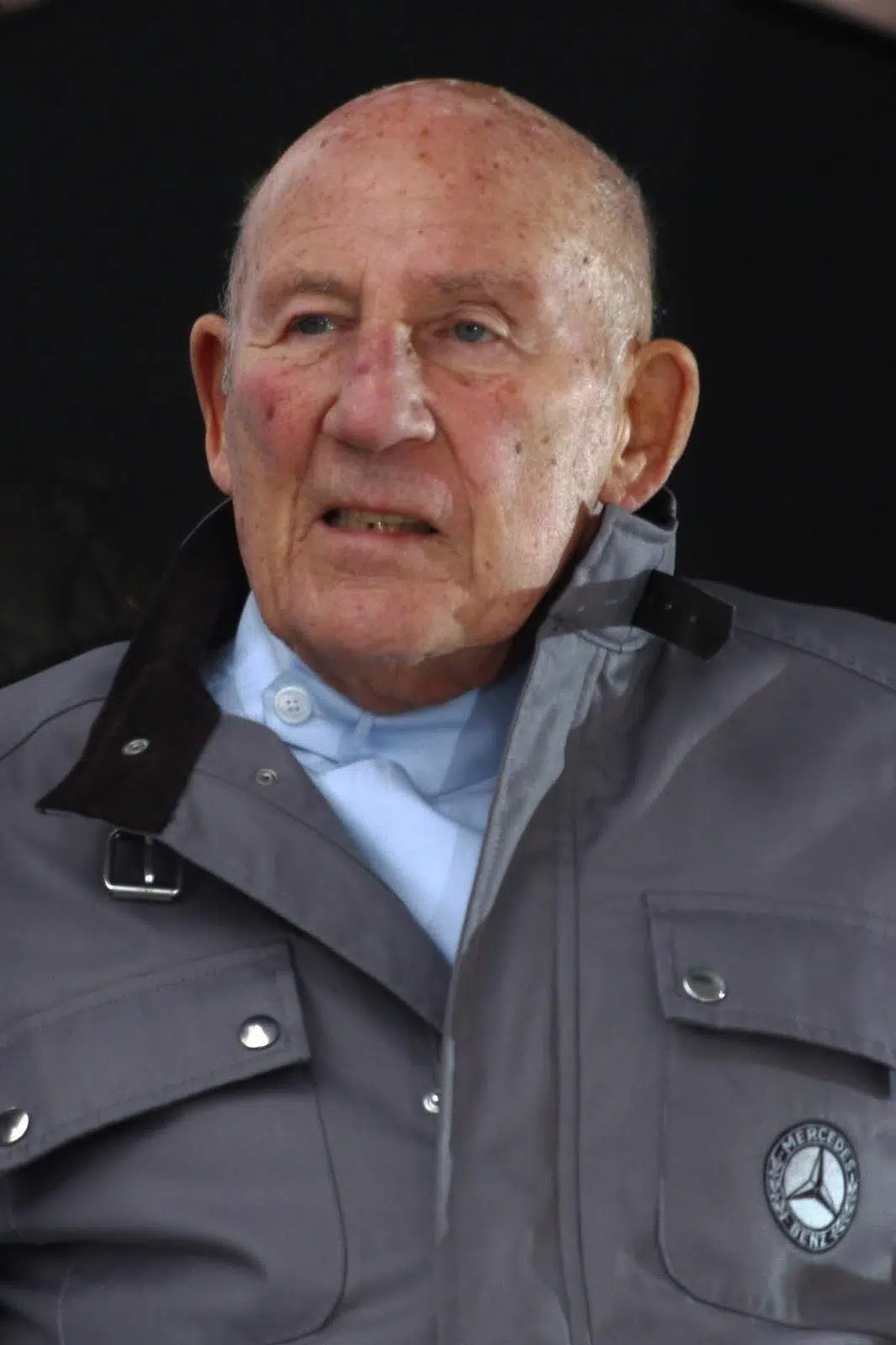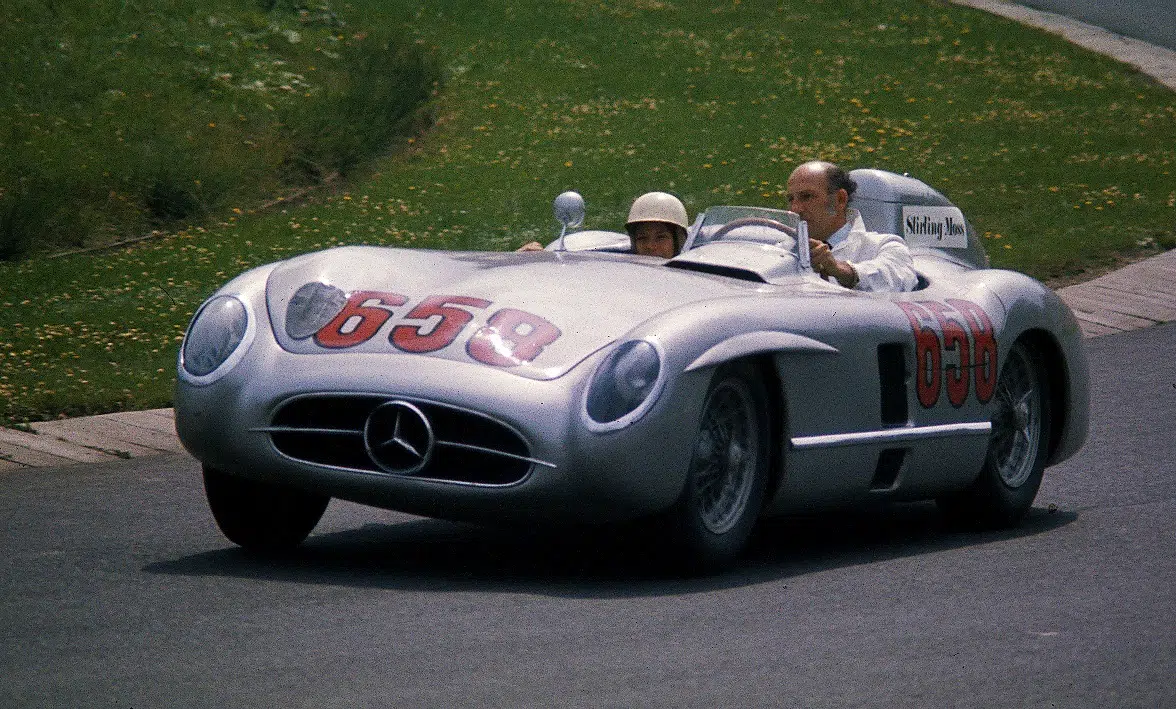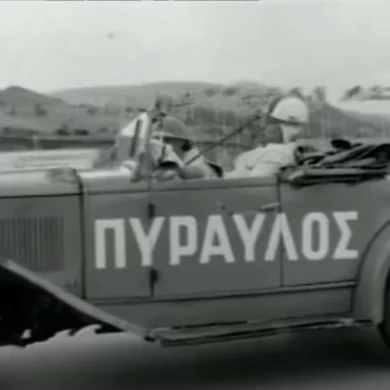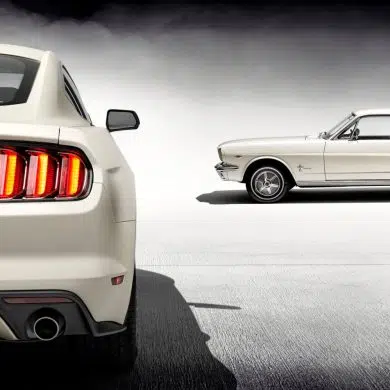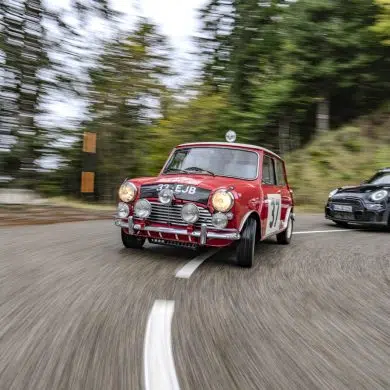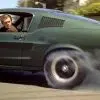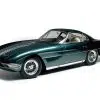Over the years, motorsport has seen many big names and many great drivers. One of them is the legendary Brit, Sir Stirling Moss, who, a member of the Motorsport Hall Of Fame, passed away on April 12, at the age of 90.
Early Life
Moss at Copenhagen Airport, 1958
Stirling Moss was born in West Kensington, London, on 17 September 1929. His grandfather, a Jew by birth, had changed his surname from Moses to Moss. Stirling grew up in Long White Cloud house, which was located on the banks of the river Thames. His father, Alfred Moss, a dentist by profession, was involved in amateur motor racing and had taken 16th place in the 1924 Indianapolis 500. His mother, Aileen Moss, was also involved in motorsport, having competed in hillclimbs before World War I, driving a Singer Nine. Stirling also had an aptitude for riding, as did his younger sister, Pat Moss, who went on to become a successful rally driver and later married Swedish rally driver Erik Carlsson.
Moss had changed a multitude of independent/private schools. He did not like school, which had an impact on his academic performance. At Haileybury School, he had been systematically and repeatedly bullied because of his Jewish background. He stated, however, that this "was a motivation for success". His first car, was an Austin 7, given to him as a gift by his father when he was only 9 years old, which he drove on the country roads around Long White Cloud house. At the age of 15, when he got his license, he got his own car. After World War II, Moss did not take the mandatory 2-year military service as he suffered from jade.
His career in motorsport
Moss took part in 529 races, of which he won 212, from 1948 to 1962, including 16 Formula 1 Grand Prix. His record is 62 races (in various categories) in one season, and he drove 84 cars from 84 different manufacturers throughout his career. He preferred to race in British cars as it was "better to lose with pride by racing a British car than to win in a foreign car", as he used to say. When he raced Vanwall, he broke the "monopoly" of Italian & German drivers in Formula 1, as Jack Brabham did with Cooper. Moss remained the British driver with the most wins until 1991, when Nigel Mansell overtook him, but with more entries.
1948 – 1954
Moss began his career in motorsport, driving his father's 328 BMW & DPX 653. He, himself, was one of the first customers of the Cooper Car Company, buying his first racing car, a Cooper 500, with the money he earned from horse racing and despite the initial objections of his father, who wanted Moss to become a dentist, as he was. Moss, soon showed his driving skills, winning both domestic and international races, going on to compete in Formula 3 with Cooper and the Kiefts, even when participating in larger events.
His first victory in an international event came on the day of his 21st birthday, where he won the RAC Tourist Trophy, in 1950, which took place at the Dundrod circuit in Northern Ireland in a borrowed Jaguar XK120. He won the event six more times, in 1951 (with the Jaguar C-Type), 1955 (with the Mercedes-Benz 300SLR), 1958 and 1959 (with the Aston Martin DBR1) and 1960 & 1961, with the Ferrari 250 GT. Enzo Ferrari had offered Moss a Formula 2 entry in the 1951 Bari Grand Prix, before a full participation in the 1952 season. However, when Stirling and his father went to Puglia, they learned on the spot that the more experienced Piero Taruffi would drive the car.
Moss was also a successful rally driver, as he was one of only three drivers to have won the Coupe d'Or (Gold Cup), with 3 consecutive penalty-free appearances in the Rally Alpine (Coupe des Alpes). He, himself, finished in 2nd place in the Monte Carlo Rally 1952, driving a Sunbeam-Talbot 90, co-piloted by Desmond Scannell and Autocar magazine editor John Cooper.
In 1954, Moss would become the first non-American driver to win the 12 Hours of Sebring, sharing the helm of Cunningham's O.S.C.A. MT4 with American Bill Lloyd.
In late 1953, Mercedes Benz racing director Alfred Neubauer contacted Moss's manager Ken Gregory, having seen what a capable driver he was. Neubauer, wanting Moss to be part of the Mercedes Grand Prix team, having seen his abilities, driving a mediocre race car, and wanting to see what he could achieve by driving a better one. Neubauer suggested that Moss buy a Maserati for the 1954 season. And so it was, Moss entered a 250F and although he was unable to score many points in the championship due to the mechanical problems his Maserati was experiencing, he always managed to be among the top positions at the start and raced to the 100% of his ability by the end of each race. Moss took his first victory in the non-championship race of Maserati's Oulton Park International Gold Cup.
In the Italian Grand Prix, at Monza, Moss passed the then leading drivers, Juan Manuel Fangio (who was driving for Mercedes) and Alberto Ascari (who was driving for Ferrari). Ascari retired due to mechanical problems, while Moss remained in 1st place until lap 68, when he too retired due to mechanical problems. Fangio won the race, while Moss pushed his Maserati to the finish. Neubauer, already impressed with Moss' abilities, signed with him immediately after the Hockenheim test in the Mercedes Benz W196.
1955
Moss' first World Championship victory came in 1955 in the British Grand Prix, which took place at Aintree, a race in which he was the first British driver to take first place. Leader of the 1-2-3-4 achieved by Mercedes, and the first time Fangio had won a race, Moss had asked Fangio (who was his friend and mentor) directly if he had let him win, as had been suggested, because of the country of the race and Moss's nationality. Fangio said he won on merit, as he was the better of the two that day. That same year, Moss won the RAC Tourist Trophy, the Targa Florio (with Peter Collins) and the Mille Miglia.
Mille Miglia
At the finish of the Mille Miglia, in Brescia
1955 was to be a historic year for Moss in the 1000 mile Mille Miglia. Doug Nye used the phrase: "The greatest one day in the history of motorsport". Moss, driven by Denis Jenkinson, completed the course in 10 hours and 7 minutes (10:07). MotorTrend wrote "The Most Epic Drive. Ever". Before the race, Fangio gave him the "magic pill", he said that although he didn't know what it contained, he said "I believe it was Dexidrine and Benzedrine, pharmaceuticals often used in endurance racing. The only goal is to stay alert, like a bomber crew." After the historic victory, Moss spent the night driving with his girlfriend to Cologne, stopping for breakfast in Munich and lunch in Stuttgart.
1956 – 1962
In 1956 & 1957, Moss wins the Nassau Cup, as part of the Bahamas Speed Week. In addition, in 1957, he won the Grand Prix that took place at the Pescara Circuit in Italy, 25 kilometres long, the longest circuit on which a Formula 1 race has ever taken place to this day. Once again, Moss demonstrated his skills and skill in long distance racing. The race lasted three hours, with Moss finishing three minutes ahead of Fangio, who started from pole position.
The Vanwall VW5, in which Moss and Brooks won the British Grand Prix, 1957
In 1958, Moss once again made his mark on motorsport history and changed the "established" image. He won the first race of the year, with his Maserati having the engine in the centre instead of at the front, a position adopted by all manufacturers until 1961. The radical change, however, was another. By 1958, all cars carried one colour, set by the FIA. Sponsored by the Eldorado Ice Cream Company, Moss's Maserati carried the colours of the company logo, not the FIA. Also, Eldorado was the first company unrelated to motorsport to sponsor it.
The spirit of fair competition, however, cost Moss the 1958 World Championship. When his teammate, Mike Hawthorn, was in danger of being denied points after the Portuguese Grand Prix, Moss defended him against the stewards. When Hawthorn had gone off the track on the uphill section of the Portuguese circuit, he backed up in his attempt to get back on it. During the reverse, however, his engine died and Moss yelled at him to move backwards into the flow of the race, downhill, so that he could restart. Thanks to his quick intervention before the stewards, Hawthorn retained his 6 points, having finished second, behind Moss. In 1958, Hawthorn was World Champion, just one point ahead of Moss. An unfortunate incident, was perhaps during one of the races, when there was a misunderstanding between Moss and his pit crew. The driver with the fastest lap earned an extra point in the championship each race. So, in one race, Hawthorn was faster than Moss and his pit crew wrote "HAWT REC" on the sign, wanting to tell him that Hawthorn had the record time. Moss, however, because his crew didn't write Hawthorn's time, misread it for "HAWT REG", where REG, meant regular laps, meaning he didn't have to try to move faster.
Moss, racing the 12 Hours of Sebring, in an Aston Martin DBR1, 1958
Moss' talent, however, went beyond Grand Prix. With his existing victories in the Tourist Trophy, the 12 Hours of Sebring and the Mille Miglia, Moss came to add 3 straight wins (1958,1959,1960) to his Nurburgring 1000km, a race which he won twice with Aston Martin (1958, 1959) and once with Maserati Tipo 61 "Birdcage", with American Dan Gurney as second driver. The two of them lost time when an oil pipe burst, but despite the relatively rainy race, they managed to take 1st place.
In the 1960 Formula 1 season, Moss won the Monaco Grand Prix, but was seriously injured during free practice at Spa Francorshamps (as part of the Belgian Grand Prix) when he lost control at the Burnerville corner, causing him to miss the next three races. He did, however, manage to participate in the last race of the year, the American Grand Prix, in which he took 1st place.
Moss (left), with Innes Ireland, Dutch Grand Prix, 1961
Για τη σεζόν του 1961, με τον νέο περιορισμό στα 1500cc, ο Enzo έριξε στην αρένα την Ferrari 156, με το νέο V6 κινητήρα. Η Climax-engined Lotus του Moss, παρόλο που υστερούσε σε δύναμη, του έφερε τη νίκη στο Grand Prix του Μονακό, τερματίζοντας 3.6 δευτερόλεπτα μπροστά απο το σερί 2-3-4 της Ferrari, με τους Richie Ginther, Wolfgang von Trips & Phil Hill. Εν συνεχεία, ο Moss έλαβε τη 1η θέση και στο μερικός βροχερό, Γερμανικό Grand Prix.
O Moss, με τη νικητηρια Lotus-Climax του, στο Γερμανικό Grand Prix, 1961
Στις 23 Απριλίου 1962, στα πλαίσια του Glover Trophy στη πίστα του Goodwood, ο Moss τράκαρε με τη Lotus του με τόση σφοδρότητα, που ήταν σε κόμμα για ένα μήνα και για άλλο μισό χρόνο, είχε μερική παράλυση στο αριστερό μέρος του σώματος του. Την επόμενη χρονιά, με το personal best χρόνο του να είναι μερικά εκατοστά πίσω απο αυτόν της περσινής χρονιάς, στα πλαίσια των δοκιμών με τη Lotus, ο Moss αποφάσισε και επίσημα, να αποσυρθεί απο την ενεργό δράση, καθώς θεωρούσε πως δεν θα μπροούσε να αποκαταστήσει την “επικοινωνία” που είχε με το αυτοκίνητο του παλιότερα.
Ρεκόρ Ταχύτητας
1950
At Autodrome de Montlhery, μία οβάλ πίστα με μεγάλη κλίση, που βρισκόταν λίγο έξω απο το Παρίσι, ο Moss μαζί με τον Leslie Johnson, οδήγησαν εναλλάξ επί 24 ώρες τη Jaguar XK120 του Johnson, με στάσεις μόνο για ανεφοδιασμό και αλλαγή ελαστικών (και οδηγού ανά 3 ώρες). Το αποτέλεσμα ; Μία μέση ωριαία ταχύτητα των 172.94 χιλιομέτρων/ώρα και συνολική απόσταση 4150.75 χιλιόμετρα. Η XK120, ήταν το πρώτο αυτοκίνητο παραγωγής, που κατάφερε να πιάσει μέση ωριαία ταχύτητα, πάνω απο 160 χιλιόμετρα / ώρα.
1952
H Jaguar XK120 του ρεκόρ, στο Goodwood Festival Of Speed, 2008
Το 1952, ο Moss μαζί με τους Johnson και Bert Hadley, Jack Fairman, ξαναγύρισαν στο Autodrome de Montlhery, με μία XK120 που ανήκε στην ίδια τη Jaguar και επί 7 24ωρα, οδηγούσαν ακατάπαυστα. Με μέση ωριαία ταχύτητα 161.43 χιλιόμετρα / ώρα, κέρδισαν 4 Παγκόσμια Ρεκόρ και 5 International Class C ρεκόρ. Η συνολική απόσταση που διύνησαν ήταν 27120.23 χιλιόμετρα.
1957
Το 1957, ο Moss, στο Bonneville Salt Flats, με το ειδικά κατασκευασμένο MG EX181, κατάφερε να επιτύχει μία μέση ταχύτητα, 395.31 χιλιόμετρα / ώρα (η μέση ταχύτητα με κίνηση προς και στις δύο αντίθετες κατευθύνσεις), σπάζοντας 5 International Class F ρεκόρ.
Η καριέρα του ως σχολιαστής
Μετά την απόσυρση του απο την ενεργό δράση, το 1962, ο Moss είχε ρόλο σχολιαστή στην εκπομπή Wide World Of Sports του καναλιού ABC, για τους αγώνες του NASCAR και της Formula 1, μέχρι το 1980. Ο Moss, συμμετείχε στην επίσημη εκπομπή της Formula 1,για την ανασκόπηση της σεζόν του 1988, μαζί με τον Tony Jardine.
O Moss, είχε ρόλο αφηγητή στη παιδική σειρά Roary the Racing Car.
Επιστροφή στους αγώνες
Στις 2 δεκαετίες που ακολούθησαν την αποχώρηση του απο την ενεργό δράση, ο Moss έκανε μερικές one-off εμφανίσεις σε κάποιες διοργανώσεις.
Το 1974, συμμετείχε στο London-Sahara-Munich World Cup Rally με τη Mercedes Benz (όπου εγκατέλειψε στην Αλγερία).
To 1976, συμμετείχε μαζί με τον Jack Brabham στο Bathurst 1000, όπου το Holden Torana τους χτυπήθηκε στο πίσω μέρος, με αποτέλεσμα να εγκαταλείψουν με μηχανική βλάβη. Ο ίδιος σχολιάστηκε αρνητικά όταν στη προσπάθεια του να επιστρέψει στα pit αφότου ο V8 κινητήρας του Holden τον άφησε απο μηχανική βλάβη, έκανε τα 2/3 του γύρου (η πίστα του Buthurst έχει μήκος 6.17 χιλιόμετρα) χάνοντας λάδια.
Το 1979, συμμετείχε μαζί με τον Denny Hulme, στο Benson & Hedges 500, με Volkswagen Golf GTi, στη Νέα Ζηλανδία.
Το 1980, επέστρεψε επίσημα στην ενεργό δράση, στο British Saloon Car Championship, σαν δεύτερος οδηγός της ομάδας Audi GTi Engineering Team του Richard Lloyd (ο οποίος ήταν και ο βασικός οδηγός).
Το 1981, o Moss παρέμεινε στην ομάδα της Audi, το management της οποίας είχε πλέον αναλάβει η Tom Walkinshaw Racing, με κύριο οδηγό τον Martin Brundle.
Moss & OSCA MT4 Spider, Sliverstone Classic, 2006
Καθόλη τη διάρκη της αποχής τους απο την ενεργό δράση, ο Moss κατά διαστήματα συμμετείχε είτε ως καλεσμένος, είτε ως εκπρόσωπος διαφόρων κατασκευαστών σε αγώνες ιστορικών αυτοκινητων, ακόμα και με το δικό του, OSCA FS 372.
Moss & OSCA FS 372 Spider Morelli, Bahamas Speed Week, 2011
Στις 9 Ιουνίου 2011, μετά τις κατατακτήριες δοκιμές του αγώνα Le Mans Legends, o Moss δήλωσε στο Radio Le Mans, την πλήρη και οριστική απόσυρση του απο την ενεργό δράση, λέγοντας πως τρόμαξε τον εαυτό του εκείνο το απόγευμα, σε ηλικία 81 ετών !
Η καριέρα μετά την απόσυρση απο την ενεργό δράση
Moss & Whittaker (Lister Cars CEO)
Τον Ιούνιο του 2016, η Lister Cars ανακοίνωσε τη κατασκευή και πώληση του Lister Knobbly Stirling Moss, στο Royal Automobile Club του Λονδίνου.
Το αυτοκίνητο κατασκευάστηκε στις ακριβής προδιαγραφές αυτού του 1958 και είναι το μοναδικό αυτοκίνητο μέχρι σήμερα, με αμάξωμα κατασκευασμένο απο μαγνήσιο. Είναι επίσης, το μοναδικό αυτοκίνητο που εγκρίθηκε για το σχεδιασμό του, απο τον ίδιο το Moss. Η σχέση του Moss με τη Lister Cars, πάει πίσω στο 1954, όπου ο Brian Lister, είχε καλέσει τον Moss να οδηγήσει τα αυτοκίνητα του στο Goodwood το 1954, στο Sliverstone το 1958 και στο Sebring το 1959.
Για να τιμήσει αυτούς τους αγώνες, η Lister κατασκεύασε 10 special-edition lightweight Lister Knobbly, τα οποία παρέδιδε ο ίδιος ο Moss στους εκάστοτε ιδιοκτήτες.
Διακρίσεις
- To 1990, o Moss έγινε μέλος του International Motorsports Hall Of Fame
- Το 2000, ο Moss ήταν Knight Bachelor για το μηχανοκίνητο αθλητισμό, στη New Year Honours 2000 List
- Το 2005, του απονεμήθηκε, το Segrave Trophy
- Το 2006, η FIA, το απένημε το χρυσό μετάλλιο, ως αναγνώριση της εκπληκτικής συνεισφοράς του στο μηχανοκίνητο αθλητισμό
- Το 2008, η Mercedes Benz, παρουσίασε τη τελευταία εκδοχή της SLR McLaren, SLR Stirling Moss, η οποία παραπέμπει έντονα, στο σχεδιασμό της αγωνιστικής 300 SLR
- Το 2016, σύμφωνα με το πόρισμα ενός πανεπιστημιακού μαθηματικού μοντέλου για την αξιολόγηση των οδηγών του μηχανοκίνητου αθλητισμού, ο Moss έλαβε την 29η θέση στη λίστα των κορυφαίων οδηγών της Formula 1
Βιογραφίες
Το 1957, ο ίδιος ο Moss, δημοσίευσε μία αυτοβιογραφία, με τίτλο “In the Track Of Speed”.
Το 1963, ο σχολιαστής και δημοσιογράφος του μηχανοκίνητου αθλητισμού, Ken Purdy, δημοσίευσε ένα βιβλίο με τίτλο “All But My Life”, με βάση τις συνεντεύξεις που είχε πάρει ο ίδιος απο τον Moss.
Το 2015, σε ηλικία 85 ετών, δημοσίευσε ένα δεύτερο αυτοβιογραφικό βιβλίο με τίτλο “My Racing Life”, γραμμένο μαζί με το συγγραφέα μηχανοκίνητου αθλητισμού, Simon Taylor.
Προσωπική Ζωή
Τον Απρίλιο του 1960, ο Moss παίρνει κλήση ύψους 50 λιρών για επικίνδυνη οδήγηση, στα πλαίσια ενός test drive που έκανε, με ένα Mini.
Στην Αγγλία, για μεγάλο χρονικό διάστημα, μετά απο ένα συμβάν όπου τον σταμάτησε ένας αστυνομικός ο οποίος αρχικά δεν πίστευε οτι ήταν ο ίδιος, έμεινε να ρωτάνε “Ποιος νομίζετε οτι είστε, ο Stirling Moss ; ¨”, όταν σταματούσαν κάποιων οδηγό που κινούνταν με υπερβολική ταχύτητα.
Το 2009, τα 80α του γενέθλια, συνέπεσαν με το 3ήμερο του Gooodwood, όπου και τις 3 μέρες, ένα convoy 80 αυτοκινήτων με 1ο οδηγό τον ίδιο, ανέβηκε το Goodwood Hillclimb. Ο Moss οδήγησε ένα διαφορετικό αυτοκίνητο, κάθε μέρα : μία Mercedes W196 “Monoposto“, τη Lotus 18 με την οποία κέρδισε το Grand Prix του Μονακό το 1961 και μία Aston Martin DBR3.
Στις 7 Μαρτίου 2010, ο Moss έσπασε και τους 2 του αστραγάλους και 4 κόκκαλα στο ένα του πόδι, όταν έπεσε στο κενό του φρεάτιου του ανελκυστήρα του σπιτιού του.
Το Δεκέμβριο του 2016, ο Moss εισήχθη με σοβαρή λοίμωξη σε νοσοκομείο της Σιγκαπούρης. Ως αποτέλεσμα αυτής της ασθένειας και της μακράς αποκατάστασης, ο ίδιος ανακοίνωσε την απόσυρση του απο το δημόσιο βίο τον Ιανουάριο του 2018.
Η σχέση του με τη Mercedes Benz και το τέλος της ζωής του
Mercedes Benz 300 SLR, Nurburgring, 1977
Ο Moss υπήρξε μεγάλος οπαδός της γερμανικής εταιρείας, με την οποία διατηρούσε σχέσεις και μετά απο το πέρας της συμμετοχής του σε αγώνες με τα αυτοκίνητα της. Ο ίδιος υπήρξε ένας απο τους σπουδαιότερους Brand Ambassador της εταιρείας, αλλά και συλλέκτης των αυτοκινήτων της, με δύο εκ’ των κορυφαίων αυτοκινήτων της συλλογής του να είναι μία Mercedes W113 και μία SLR Stirling Moss.
Ο Stirling Moss, μετά απο μία μακρά ασθένεια που τον ταλαιπώρησε για μεγάλο χρονικό διάστημα, απεβίωσε στο σπίτι του στο Mayfair του Λονδίνου, στις 12 Απριλίου 2020.
Rest In Peace, Sir Moss.


